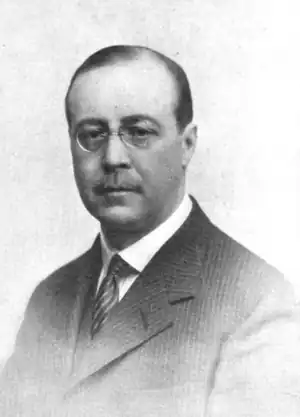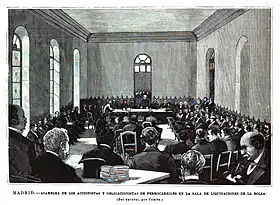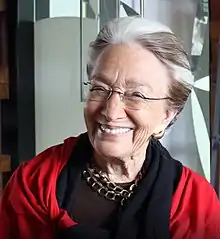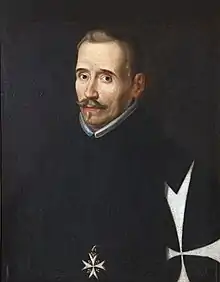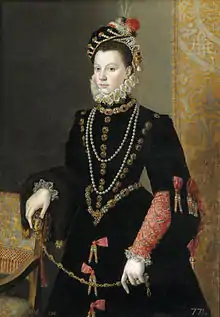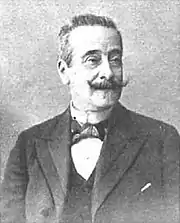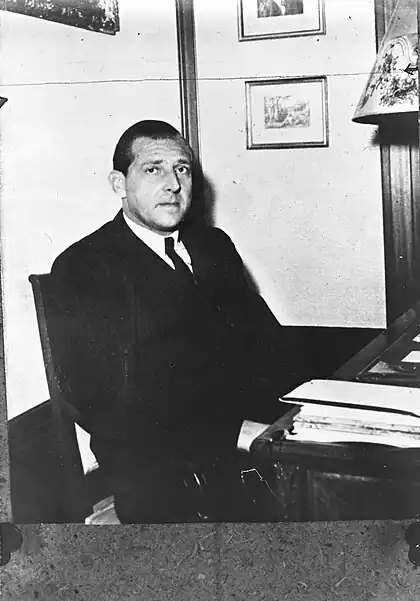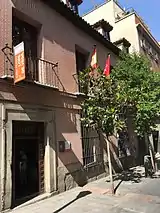Agustín González de Amezúa | |
|---|---|
| Born | Agustín González de Amezúa y Mayo 30 August 1881 Madrid, Spain |
| Died | 10 June 1956 (aged 74) Madrid, Spain |
| Nationality | Spanish |
| Occupation | entrepreneur |
| Known for | academic |
| Political party | Integrism, Carlism |
| Seat Z of the Real Academia Española | |
| In office 24 February 1929 – 10 June 1956 | |
| Preceded by | José Rodríguez Carracido |
| Succeeded by | Agustín de Foxá |
Agustín González de Amezúa y Mayo (30 August 1881–10 June 1956) was a Spanish academic, member of Real Academia Española, Real Academia de la Historia and Real Academia de Jurisprudencia y Legislación. He is best known as historian of literature who specialized in Siglo de Oro, especially in works of Cervantes and Lope de Vega. He held various important scientific posts during early Francoism, especially in Consejo Superior de Investigaciónes Científicas. Politically he supported the Traditionalist cause, first as an Integrist and then as a Carlist militant; in the early 1940s he was in national executive of Comunión Tradicionalista. In the mid-1920s he was member of the Madrid ayuntamiento.
Family and youth
None of the sources consulted provides information on González de Amezúa’s distant ancestors; some authors claim that the family originated from La Rioja.[1] His father, Enrique González de Amezúa y Muñoz (died 1909),[2] was a member of mid-range Madrid bourgeoisie.[3] At least since the late 1860s he had been working as a broker at the stock exchange and reportedly greatly contributed to its operations during the turbulent times of the Glorious Revolution and the early Restoration.[4] Over time he became one of the most prestigious brokers; in the late 1890s he was a member of Junta Sindical of the Colegio de Agentes de Cambio y Bolsa,[5] and in the early 20th century he became the president of the body.[6] At an unspecified time he married Luisa Mayo Albert (died 1934),[7] a descendant of a well-off family involved in trade and finances. Her father and Amezúa’s maternal grandfather Manuel Mayo de la Fuente originated from the Philippines;[8] he became a distinguished lawyer[9] and landholder.[10] In the mid-1860s he served two terms in the Cortes[11] and was Director General de Contribuciones in the Ministerio de Hacienda.[12]
Enrique and Luisa settled in Madrid. They had nine children, born between the mid-1870s and the late 1880s; three of them perished either in infancy or in their youth.[13] Agustín was born as the third oldest son; all received very religious and pious educations.[14] In the mid-1890s he frequented the Jesuit college in Valladolid, where he obtained the bachillerato.[15] At an unspecified time in the late 1890s he entered the faculty of law at Universidad Central in Madrid. Some sources claim he graduated in 1901,[16] but others point rather to 1902;[17] his thesis was titled Historia de la Paz y Tratado de los Pirineos que se concluyó a 7 de noviembre de 1659.[18] Amezúa entered the bar and was employed in the office of "a known lawyer" in Madrid;[19] some authors are more specific and maintain that he practiced in the firm of Luis Díaz Cobeña.[20]
In 1911[21] Amezúa married Primitiva Noriega González (died 1983); there is nothing known about her or her family.[22] The couple lived in downtown Madrid and had five children, born between the early 1910s and the late 1920s.[23] The oldest sons, Javier and Álvaro, were killed by the Republicans during an early stage of the civil war.[24] Ramón became an engineer and a nationally recognized organist; from 1991 to 2008 he presided over the Real Academia de Bellas Artes and until 2007 he led the executive board of TeleMadrid.[25] The youngest child, Clara María, is a living legend of Spanish gourmet.[26] The best known of Agustín’s grandchildren is Mercedes González de Amezúa y del Pino, a historian of art, curator and author.[27] Among Agustín’s siblings[28] the oldest brother Manuel became a businessman, but he is known rather as co-founder of the Club Alpino Español.[29] The youngest brother Enrique entered diplomacy and served on foreign missions for the Republic and for Francoist Spain.[30] Agustín’s maternal uncle was the Integrist political leader, Ramón Nocedal.[31]
Man of affairs
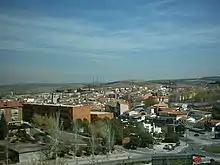
Amezúa’s practice as a lawyer did not last long,[32] though it is not clear exactly when he abandoned the bar and switched to business.[33] At an unspecified time in the early 20th century he either inherited or otherwise assumed management of the La Poveda sugar plant in Arganda del Rey, built probably by either one of his ancestors or one of his relatives.[34] Apart from daily business, he remained fairly active also as a theorist; in 1917 he released La cuestión del azúcar. Observaciones sobre su tasa, in 1918 La cuestión del azúcar. Informes y observaciones elevados a los poderes públicos,[35] and in 1924 Memoria de las mejoras introducidas en la Fábrica y Ferrocarriles de la Sociedad Azucarera de Madrid.[36] In the mid-1920s he represented Industria Azucarera Española in the Consejo de la Economía Nacional, and voiced in issues related to the sugar trade with Cuba and numerous other issues of the sugar industry.[37] In the late 1920s he rose to high positions in Sociedad Azucarera de España, the Spanish sugar trust,[38] and co-ordinated some of its projects also in the early 1930s.[39]
At an unspecified time Amezúa engaged also in the alcohol industry. In 1932 he was among the top managers of the Asociación de Fabricantes de Alcoholes Industriales and represented the institution in the newly formed Instituto Nacional del Vino.[40] After the war he was the managing director of the Unión Alcoholera Española S.A.,[41] and in name of the holding in 1940 he negotiated refurbishment of manufacturing premises in Valencia.[42] In the early 1940s he presided over the Organería Española.[43] It was his son who played a part in Amezúa’s engagement in Ferrovial,[44] the construction-transport conglomerate set up by Rafael de Pino in 1952. Ramón was married to his sister; Pino concluded that a prestigious academic with a business background would help him open many doors, and offered Amezúa the position of president of the board. The plan worked out and the same year Ferrovial closed the first deal with RENFE.[45] According to one source Amezúa held some roles in the Banco de España, but there are neither details nor confirmation provided.[46]
_01.jpg.webp)
Amezúa was fairly successful as a businessman and already in the early 1920s he was an affluent member of the Madrid bourgeoisie. In 1924 he contracted Luis Gutiérrez Soto,[47] at the time the Chief Architect of the Ministry of Public Instruction, to design his house in the prestigious so-called Triángulo Cultural quarter in Madrid.[48] It was completed by other architects as a palacete with eclectic, historicist, regionalist, and baroque features; the front was occupied by a giant, two-storey library. Amezúa lived there during the following thirty-two years;[49] currently the building serves as Casa de Galicia, the property of regional Galician authorities.[50] In 1940 Gutiérrez Soto designed also the refurbishment of Amezúa’s property near his sugar plant in Arganda del Rey,[51] known as Vilches, which was further upgraded in 1956.[52] Amezúa owned also another rural estate, his favorite summer getaway, named Dehesa de Cid and located in the village of Sanchorreja near Ávila.[53]
Historian of literature
Though a lawyer by profession, Amezúa developed an interest in letters and history. He was inspired mostly by his erudite uncle Ramón Nocedal[54] and his guests met during weekly intellectual sessions, mostly Marcelino Menéndez y Pelayo; despite the age difference, the two became close friends.[55] In his research Amezúa focused almost exclusively on the so-called Siglo de Oro and became an acknowledged cervantista. Already in 1909 the Real Academia de la Lengua rewarded him with the Medalla de Oro for a critical edition of El casamiento engañoso and El coloquio de los perros by Cervantes, to be published in 1912.[56] However, his key work is Cervantes creador de la Novela corta española (1956), a multi-volume edition of Cervantes’ stories with innovative and massive analytical introduction.[57] He also prologued or contributed to a number of studies or re-editions[58] and published a handful of shorter articles on the author of Don Quijote in the popular press.[59]
Another of Amezúa’s favorite authors was Lope de Vega. The work which stands out is Epistolario de Lope de Vega Carpio (1935-1943), a four-volume publication of Lope’s correspondence accompanied by an extensive and rigorous analytical study. Far smaller was Una colección manuscrita y desconocida de comedias de Lope de Vega Carpio (1945), an edition of previously unpublished theatrical pieces. Un enigma descifrado. El raptor de la hija de Lope de Vega (1934)[60] was a historiographic-literary study upon a mysterious episode from Lope’s life. His opus was complete with a number of minor works, published as prologues to re-edited Lope de Vega works or as articles in scientific reviews or in daily newspapers.[61]
Among studies dealing with other authors of the Siglo de Oro the one of particular weight was Formación y elementos de la novela cortesana (1929), the study on the emergence of a genre that he dubbed “courtly novel”;[62] he listed three of its typical features, namely urban setting, aristocratic characters, and "erotically motivated" plot.[63] He also studied, edited, and published works of somewhat forgotten authors, like Juan Rufo (1923), Juan Enríquez de Zúñiga (1932), Antonio de Torquemada (1943), Alonso de Meneses (1946), Andrés Rey de Artieda (1947), Juan Pérez de Montalbán (1949), Diego de San Pedro (1952) and Juan de Flores (1954).[64] Other minor works include studies dedicated to Menendez Pelayo, typography, polemical debates, the Spanish reception of Dante and other topics.[65] Amezúa’s contribution to the history of Spanish literature consists also of his documentary passion. He inherited Nocedal’s massive collection of old prints[66] and enlarged it in the course of the following decades, purchasing manuscripts, old books, and acquiring private collections, e.g. the correspondence between Benito Pérez Galdós and Emilia Pardo Bazán.[67] He donated the entire collection to the Real Academia Española in 1953.[68]
Historiography, periodismo and political theory
Historiography was, after literature, another field where Amezúa contributed with some high quality works. The most significant one is a multi-volume study on the Spanish Renaissance queen Isabel de Valois (1949);[69] the same ruler was offered also a minor article.[70] Another major study was La batalla de Lucena y el verdadero retrato de Boabdil (1915), a 200-page analysis of an episode from the very late period of the Reconquista. Mid-size works are Andanzas y meditaciones de un procurador castellano en las Cortes de Madrid (1945) and Un modelo de estadistas. El marqués de la Enseñada (1917), the latter uniquely going beyond the Golden Age period. Minor contributions are articles scattered across scientific periodicals and dealing with various aspects of 17th century Spain, including municipal regulations, early police forces, distinguished personalities or travelling.[71] Amezúa also prologued a number of publications, including sets of modern era documents, reprints of older books or bibliographical collections.[72]
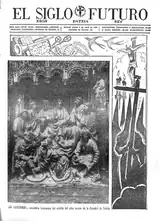
From the early 1900s till the 1930s Amezúa published some thirty culture-focused articles in El Siglo Futuro,[73] usually unsigned or signed with a pen-name "Zeuma".[74] In the 1940s and 1950s he contributed some 100 pieces to ABC and La Vanguardia;[75] apart from a few exceptions they all dwelled on the history of literature and culture,[76] though some contained political undertones, e.g. related to Gibraltar.[77] His particular focus was on lexicology and revealed that he aspired to a normative role; Amezúa campaigned against foreign words or regionalisms and advocated the purity of the language; he tried to invent words supposed to replace foreign intrusions, e.g. "navideña" instead of "Christmas" (adjective) and "popularismo" instead of "folklore".[78] A contemporary scholar describes him as "amante del español castizo, cultivador de un estilo arcaizante".[79] Another area of Amezúa’s publishing activity was political theory; like in literature and historiography, he excelled in editorial work and providing introductory or analytical commentary. This was the case with Obras de don Ramón de Nocedal (1907-1914), which gathered articles, manuscript works, and Cortes addresses by the master of his youth. Another example is a prologue to Política general by Juan Vázquez de Mella, (1932), already calibrated as a Traditionalist propaganda publication with contributions of Conde Rodezno, Víctor Pradera, Salvador Minguijón or Miguel Fernandez Peñaflor;[80] there are also other minor pieces.[81] Most of his smaller works, including these from the history of literature, were re-published or published in three volumes of the Opúsculos Histórico-Literarios (1951-1953). One scholar writing in 1958 identified his seventy-nine works in total,[82] but recently another student arrived at 250 titles.[83]
Academic
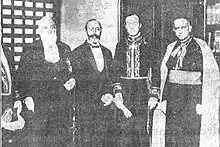
Since the late 1900s Amezúa focused almost entirely on science, and in 1909 his treatise on Cervantes, to be published few years later, earned him the Medalla de Oro of the Real Academía de la Lengua.[84] In 1912 he became the librarian of the Academia de Jurisprudencia y Legislación.[85] In 1914 he was the moving spirit behind the setup of Sociedad de Bibliófilos Españoles[86] and later labored to publish many of its luxurious publications.[87] In 1929 he entered the Real Academia de la Lengua, the highest Spanish authority in the world of letters; his entry lecture was Formación y elementos característicos de la novela cortesana.[88] In the name of RAE he worked to reclaim the original house of Lope de Vega in Madrid; when successful in 1930,[89] he managed the refurbishment works.[90] In 1935 he entered the Junta Protectora de las Bibliotecas y Archivos Ecclesiásticos, a body set up by the Church and entrusted with protection of its written heritage.[91] In 1938[92] Amezúa was nominated treasurer of the Insituto de España, a freshly created Francoist body intended to replace Junta de Ampliación de Estudios.[93] It was soon replaced by the Consejo Superior de Investigaciónes Científicas; within CSIC he later presided in perpetuity over a sub-section named Patronato Saavedra Fajardo.[94] In 1939 he became the treasurer of the Real Academia Española[95] and soon afterwards he was nominated to the Junta de Patronato de la Biblioteca Nacional.[96] In 1940 he emerged as hermano mayor of the newly created Pontificia y Real Asociación de Represión de la Blasfemia.[97] In 1941 he took management of the Centro de Estudios de Lope de Vega, his personal brainchild intended to protect Lope’s patrimony and to study and propagate his works;[98] however, the institution operated briefly and was later incorporated into the RAE structures.[99] In 1942 Amezúa was elected to the Real Academia de la Historia; he took his seat in 1944[100] with the lecture Una reina de España en la intimidad: Isabel de Valois.[101]
_02.jpg.webp)
In 1945 Amezúa entered the third royal academy, this time the Real Academia de Jurisprudencia y Legislación; his entry lecture was Andanzas y meditaciones de un procurador castellano en las Cortes de Madrid de 1592 a 1598.[102] In 1951 he was among the founding members[103] of the Instituto de Estudios Madrileños; according to some authors he served as its president until his death[104] and according to some until the mid-1950s.[105] In 1951 he travelled to Mexico as head of the Spanish delegation for the I Congreso de Academias de la Lengua Española[106] and worked to create the Asociación Internacional de Academias de la Lengua Española.[107] From 1951 to 1956 he presided over the Comisión Permanente del Congreso de Academias de Lengua.[108] In 1952 Amezúa was among the founding fathers of the Sociedad Española de Publicistas.[109] In 1953 he was elected director of the Real Academia de Historia and directed it until his death.[110] In 1956 he was active preparing the II Congreso de Academias da la Lengua Española;[111] shortly before his death he assumed management of Boletín de la Real Academia de la Historia.[112]
Between Integrism and Carlism
Amezúa’s parents politically supported the Traditionalist branch, since the 1880s known as Integrism.[113] As a young man Agustín was particularly influenced by its leader and his maternal uncle, the charismatic Ramón Nocedal. The families lived closely[114] and Amezúa spent hours in Nocedal’s enormous library; he also at least witnessed intellectual sessions staged there and naturally absorbed the Integrist outlook.[115] Already during Nocedal’s lifetime he started to edit and publish his works; after Nocedal’s death in 1909 he completed the task in 1914.[116] Since 1905, and during the 1910s and 1920s he kept contributing to the flagship Integrist newspaper, the Madrid-based El Siglo Futuro. He signed only a few pieces. Most are unsigned or signed with pen-names.[117] However, in his contributions he stayed clear of politics and ideology; some thirty articles focused rather on culture and grand Spanish literature.[118]
Amezúa’s first steps in politics are not clear. In 1924 he entered the Madrid ayuntamiento;[119] during the Primo de Rivera dictatorship its members were not elected but nominated by the civil governor. None of the sources consulted clarifies what mechanism got him elevated to the town hall. He remained a rather active councilor, especially after he entered and then assumed the presidency of the Comisión de Hacienda. Amezúa worked to re-organize municipal economic structures,[120] especially with regards to tenancy[121] and city-controlled companies;[122] he remained engaged in the development of the local tram network[123] and was behind improvements to the Canal de Isabel II, the urban water supplier.[124] His term expired in 1927;[125] it is not clear whether he resigned or was not re-appointed. His only official engagement prior to the fall of the monarchy was the 1930 appointment to the Comisión Mixta Arbitral Agraria, an arbitrary board set up by the Ministerio de Trabajo y Previsión.[126]

The advent of the Second Republic produced rapprochement between various Traditionalist branches. At the turn of 1931 and 1932 the Integrists merged within the Carlist organisation, the Comunión Tradicionalista; Amezúa was among a strong and robust Integrist contingent.[127] He focused on culture. In 1933 he started publishing single pieces in an ambitious Carlist review, entitled Tradición;[128] and two years later he entered its editorial board.[129] In 1934 he was nominated to the Consejo de Cultura, a body designed as guardians of Traditionalist orthodoxy,[130] kept contributing to the now semi-official Carlist daily El Siglo Futuro[131] and delivered lectures at Carlist gatherings, e.g. during the Congreso Nacional de Juventudes Tradicionalistas.[132] In 1935 the claimant Alfonso Carlos nominated him to another body, the Consejo de Hacienda, supposed to look after the party finances.[133] Amezúa’s stand with regard to dilemmas of Carlist politics is not clear; however, in 1934 he was a member of the Junta Directiva of Acción Española, a platform which advanced dynastical reconciliation and united some Carlists and some Alfonsists.[134]
Between Carlism and Francoism
Amezúa was at least aware of the anti-Republican conspiracy of 1936, as his two oldest sons were actively engaged in the Madrid requeté preparations.[135] In the chaos which engulfed the capital on July 18/19 Javier and Álvaro failed to make it to the Montaña barracks and soon had to go into hiding, to be captured and killed later. Amezúa also soon decided to seek shelter in an unidentified foreign legation.[136] He was evacuated from the Republican zone some time in 1937, as in early 1938 he was already nominated to the Francoist Instituto de España, based in Burgos;[137] he returned to Madrid in 1939. Amezúa remained engaged in the semi-legal, independent Carlist current. When Misión, the party review styled as a generic Catholic periodical, was in 1940 moved from Pamplona to Madrid, he entered its broad editorial board.[138] In 1943 he co-signed the so-called Reclamación del Poder, a letter by key Carlist pundits addressed to Franco; the signatories demanded introduction of the traditionalist monarchy.[139] The same year the regent-claimant Don Javier nominated him to the Junta Nacional, the collegial executive.[140] However, at the time Amezúa again demonstrated some leaning towards some sort of dynastic reconciliation. In 1944 he supported the suggestion of the Navarrese leader Jesús Elizalde that the Alfonsist claimant Don Juan be cautiously approached.[141] In 1945 he seemed sympathetic towards the proposal of Araúz de Robles, namely that a collective Regencia Nacional be set up.[142]
In 1946 it was already clear that “within the Carlist structures there was a pro-juanista current, which though not significant numerically, remained quite active especially given political weight of its representatives, principally José M. Arauz de Robles and Agustín González de Amezúa.”[143] The same year he wrote a lengthy memorandum addressed to Conde Rodezno, the chief Juanista at the time already beyond the party discipline. Amezúa’s suggestions bordered loyalty to the regent; he advocated nomination of new the Junta Nacional, clarification of the regency question, forging a specific and clear line versus the regime and other monarchist currents, re-organizing Comunión and approaching Don Juan with a view of him adopting the traditionalist principles.[144] According to the Carlist political leader Manuel Fal Conde the solutions advanced in the memorandum were tantamount to "liquidar nuestra existencia, cancelar un siglo de sustentación de verdad".[145]
There is no follow-up known and it seems that Amezúa decided to remain loyal to Fal and Don Javier, yet he apparently withdrew into the back row ; there is no information on his party activities in the late 1940s and the early 1950s.[146] Though a member of the highest scientific institutions of early Francoism, Amezúa did not engage in the regime politically. He remained the advocate of dynastic reconciliation and Don Juan as the future Carlist king. In 1955 he met Don Javier when the regent briefly stayed in Madrid.[147] When in early 1956 the claimant visited Spain and resided in San Sebastían, Amezúa travelled there, met him and once more endorsed the Juanista option, apparently with the regent increasingly leaning towards it.[148]
Reception and legacy

In the 1910s and 1920s Amezúa was known only by a limited circle of El Siglo Futuro readers and by some scholars of literature. He gained nationwide recognition upon his 1929 entry to the Real Academia de la Lengua, which was acknowledged in a number of major press titles.[149] However, until the outbreak of the Civil War he was not a nationwide acknowledged public figure. It was only upon his entry to the Real Academia de Historia and the Real Academia de Jurisprudencia y Legislación in the mid-1940s that he became “uno de los prohombres de la intelectualidad franquista”, one of the top intellectuals of early Francoism.[150] His funeral was attended by many distinguished personalities including the president of the RAE, Ramón Menendez Pidal;[151] obituary notes were written by – among others - Ramón Menéndez Pidal, Ramón Pérez de Ayala, and Gregorio Marañón.[152]
Since the 1960s Amezúa was gradually falling into oblivion. None of his works has been reprinted. Today they might be either briefly mentioned or merely footnoted in studies on Cervantes,[153] Lope de Vega,[154] Zayas,[155] Quevedo,[156] prints in old Spain[157] or even more distant works on slavery and communication.[158] His most important scientific contribution is supposed to be the term novela cortesana, the courtly novel,[159] a category accepted and reproduced by present-day historians of literature; some even admit that it triggered an “astonishingly productive new direction in Golden Age studies, it has survived a half century of scrutiny and debate”.[160] In historiography some scholars recommend his documentary compilations or works on Isabel de Valois.[161]
Today González de Amezúa is dedicated short biographical notes on websites of the Real Academia Española,[162] the Real Academia de la Historia[163] and the Instituto de Estudios Madrileños.[164] He has earned few brief monographs, apart from bibliographical queries, chiefly an article focused on his contribution to IEM.[165] In Spanish public discourse he is rather absent; his memory was eclipsed by the personality of his children, especially Ramón in the world of arts and Clara María in the world of gourmet. If recalled, it is to emphasize the work of Antonio Rodríguez Moñino, a Republican who saved his library during the civil war.[166] Some works referring to Amezúa’s contribution of historian of literature stigmatize him as an anti-Semite[167] or a machista.[168] An American scholar lambasted him as “crítico fascista”, who, driven by his own personal experience – especially the Catholic upbringing and the Jesuit college frequented – entirely misrepresented Cervantes and focused on marginal threads of his works and lifetime, e.g. the Valladolid spell; he does not spare damning qualifications like “fascist”, “catolicismo jesuita de Amezúa” or “crítico bajo el techo del franquismo”.[169] Few works note him as a protagonist of Carlism in the early Francoist era.[170] In Madrid there is a large plaza named after him, though there were attempts to rename it in line with the Historical Memory Law.[171]
See also
Footnotes
- ↑ see e.g. Typewritten letter to Estrella Gutiérrez, [in:] Abebooks service, available here. Some authors even claim that he was from La Rioja himself, see e.g. “el historiador, jurista y crítico literario riojano Agustín González de Amezua”, José Alberto Vallejo del Campo, Menéndez Pelayo en el pensamiento jurídico contemporáneo, Madrid 2020, ISBN 9788429021301, p. 44
- ↑ La Correspondencia da España 11.03.09, available here
- ↑ there is nothing known about his ascendants. A certain Juan González de Amezúa was noted in Madrid in 1837 as related to El Español, but it is not clear whether he was family related, El Español 21.11.37, available here
- ↑ La Epoca 11.03.09, available here
- ↑ La Correspondencia de España 22.01.00, available here
- ↑ El Globo 24.01.00, available here
- ↑ González de Amezúa y Mayo, Agustín (1881-1956), [in:] Archivo RAE service, available here
- ↑ his father and Amezúa’s great-grandfather Francisco Mayo Barrera (1767-?) was one of the managers of the Royal Company of the Philippines (Real Compañía de Filipinas), ABC 04.06.52, available here
- ↑ Patrimonio documental del Ilustre Colegio de Abogados de Madrid, available here
- ↑ Matías Fernández García, Parroquia madrileña de San Sebastián: algunos personajes de su archivo, Madrid 1995, ISBN 9788487943393, p. 266. Though he left the Philippines at the age of 9 months, in Spain he published some works about the islands, see Enrique Arias Anglés, Relaciones artísticas entre España y América, Madrid 1990, ISBN 9788400070656, p. 469
- ↑ in 1864 and 1867, both times from Pontevedra, Mayo de la Fuente, Manuel, [in:] official Cortes service, available here
- ↑ La Correspondencia de España 03.04.92, available herea
- ↑ for Iñigo see La Correspondencia de España 20.06.98, available here he died before 1909, as is not listed in father’s death notice, La Correspondencia de España 11.03.09, available here, María Amalia died in 1883 as a child, La Correspondencia de España 16.12.83, available here. For María de las Mercedes (1885-1898) see La Correspondencia de España 20.06.98, available here
- ↑ an Integrist daily referred to González de Amezúa Muñoz as a model Christian father, El Siglo Futuro 11.03.09, available here
- ↑ ABC 12.06.56, available here
- ↑ Agustín González de Amezúa y Mayo, [in:] Real Academia de Historia service, available here
- ↑ ABC 12.06.56, available here
- ↑ David González Ramírez, Marcelino Menéndez Peyalo: ‘Nació prodigo; vivió como un sabio; expiró como un santo’; recuerdos personales de Agustín González de Amezúa, [in:] AnMal XXXIV/2 (2011), p. 580
- ↑ "un abogado de renombre", González Ramírez 2011, p. 580
- ↑ Agustín González de Amezúa y Mayo, [in:] Real Academia de Historia service, available here
- ↑ Carta de Agustín González De Amezúa a Marcelino Menéndez Pelayo [19.02.1911], [in:] Biblioteca Virtual Miguel de Cervantes service, available here. Marcelino Menendez Pelayo was invited to Amezúa’s wedding as a witness, González Ramírez 2011, p. 581
- ↑ apart that she was daughter to María de la Asunción, ABC 19.07.83, available here
- ↑ Javier (1912-1936), Álvaro (?-1936), Ramón (1921-2015), Maria del Buen Consejo (?-2020) and Clara María González de Amezúa Noriega (b. 1929)
- ↑ La Vanguardia 18.07.54, available here
- ↑ see e.g. Ramón González de Amezúa, [in:] Real Academia de la Historia service, available here
- ↑ see e.g. A gastronomic pioneer, [in:] Google Arts & Culture service, available here
- ↑ Gonzalez Amezua Pino Mercedes, [in:] Abebooks service, available here
- ↑ the lesser known ones were José María (?-died 1928), active on stock exchange, La Correspondencia de España 12.01.14, available here, María de la Soledad, married to embassador in Chile Luciano López Ferrer, El Debate 05.12.34, available here, María Luisa (1880-1957), married to Lucio Elío y Coig, III Conde de Casa Real de la Moneda, María Teresa Elío y González de Amézua, IV Condesa de Casa Real de Moneda, [in:] Geni genealogical service, available here
- ↑ Magdalena Velasco Kindelán, Historia del Twenty, [in:] Club Alpino Español service, available here
- ↑ he entered diplomatic service in 1920, La Correspondencia de España 02.02.20, available here. When a consul in Dreseden in July 1936 he sided with the rebels, was dismissed by the Republican government and released from service, Le Temps 02.09.36, available here. For his service in Francoist Spain see Imperio 25.04.50, available here
- ↑ Agustín’s mother, Lucia Mayo Albert, was sister to Amalia Mayo Albert (1853-1922), the wife of Ramón Nocedal, Fernández García 1995, p. 49
- ↑ David González Ramírez, Divulgación y lexicología: Agustín González de Amezúa y su labor periodistica, [in:] BRAE XCVI (2016), p. 430
- ↑ he considered himself "hombre de acción", González Ramírez 2016, p. 430
- ↑ Avanzando por el siglo XIX, [in:] Arganda municipal archive, available here, p. 527
- ↑ David González Ramírez, Itinerario bibliográfico de un estudioso del Siglo de Oro: Agustín G. de Amezúa y Mayo, [in:] Boletín de la Biblioteca de Menéndez Pelayo LXXXVII (2011), p. 227
- ↑ González Ramírez 2011, p. 228
- ↑ compare Informe que el vocal representante de la Industria Azucarera Española en el Consejo de la Economía Nacional D. Agustín G. de Amezúa eleva al mismo Consejo, como antecedente e información para las negociaciones del tratado comercial entre España y la República de Cuba (1925), Informe que el vocal representante de la Industria Azucarera Española Agustín G. de Amezúa eleva sobre la petición de auxilio formulada por la S.A. Bética Cooperativa Agrícola Industrial (1926)
- ↑ Crónica de la codificación española. Codificación mercantil, vol. 6, Madrid 1998, ISBN 9788477879251, p. 738
- ↑ in 1934 he represented Sociedad General de Azucarera de España in talks with Dirección de Aduanas; the negotiations were related to sugar industry infrastructure in Andalusia, Francisco José Sánchez Sánchez, El Duque de San Pedro de Galatino y la azucarrera de Láchar, [in:] Opción 31/1 (2015), p. 650
- ↑ La Libertad 20.11.32, available here
- ↑ González de Amezúa y Mayo, Agustín (1881-1956), [in:] Archivo RAE service, available here
- ↑ BOE 14.06.40, available here
- ↑ the company in fact set up and managed by his son, Ritmo June 1941, available here
- ↑ González Ramírez 2016, p. 430
- ↑ Rafael Castro Balaguer, Rafael de Pino y Montero – Ferrovial (1), [in:] Finanzas para mortales website 11.07.17, available here
- ↑ Agustín González de Amezúa y Mayo, [in:] Real Academia de Historia service, available here
- ↑ Miguel Angel Baldellou, El Madrid de Gutiérrez Soto, [in:] Revista de Arquitectura 312 (1997), pp. 84-90
- ↑ Alberto Sanz Hernando, Virginia Torres Solana, Arganda del Rey, [in:] Arquitectura y desarollo urbano; Comunidad de Madrid, Madrid 2004, ISBN 8445126962, pp. 94, 117
- ↑ Agustín González de Amezúa, [in:] Memoria de Madrid service, available here
- ↑ Nuestra casa, [in:] Xunta de Galicia service, available here. It is not clear how the house ended as Casa de Galicia. It is known that Amezúa's maternal grandfather was related to Galicia as a Cortes deputy from Pontevedra, but no other link has been established
- ↑ Angel Baldellou 1997, pp. 84-90
- ↑ Boletin Oficial de la Provincia de Madrid 16.07.56, available here
- ↑ ABC 12.06.56, available here. The estate is still in hands of his descendants, see Un vaquero con buen regate, [in:] Diario de Valladolid 25.04.17, available here
- ↑ it was thanks to Ramón Nocedal that Amezúa developed interest in letters and history; he kept visiting Nocedal’s enormous library and spent days there, ABC 12.06.56, available here
- ↑ González Ramíres 2011, p. 580. Amezúa declared later that his masters were Menendez Pelayo and Francisco Rodríguez Marín, Juana de José Prades, Necrologia. Agustín González de Amezúa y Mayo, [in:] Revista de Filologia Española XLII/4 (1958-9), p. 356
- ↑ Tesoros de la Real Academia de la Historia, Madrid 2001, ISBN 9788489512887, p. 314
- ↑ full title Cervantes creador de la Novela corta española. Introducción a la edición crítica y comentada de las “Novelas Ejemplares”, Madrid 1956
- ↑ Prólogo, [in:] Verardo García Rey, Nuevos documentos cervantinos (1929), Bibliografla. Sobre: Catdlogo de la Exposición celebrada en la Biblioteca Nacional en el tercer Centenario de la publicación del “Quijote” (1905); Epilogo, [in:] Miguel Cervantes, El ingenioso hidalgo don Quijote de la Mancha (1948); Lugar de nacimiento de Miguel de Cervantes Saavedra, [in:] BRAH (1953); Una carta inédita y desconocida de Cervantes, [in:] BAE (1954); Prólogo, [in:] Francisco Rodríguez Marín, Estudios cervantinos (1947).
- ↑ Anti-cervantismo, [in:] El Siglo Futuro (1905); Cervantes Alter, [in:] El Siglo Futuro (1905); Crónica literaria. Sobre: El ingeñoso hidalgo don Quijote de la Mancha, [in:] El Siglo Futuro (1916); El secreto de Cervantes, [in:] El Correo Español (1916); Un enigma cervantino [in:] ABC (1949); Un aniversario cervantino, [in:] La Vanguardia Española (1953)
- ↑ Un enigma descifrado. El raptor de la hija de Lope de Vega, [in:] BAE (1934)
- ↑ Unas honras fruststradas de Lope de Vega, [in:] RHI (1933); En el tercer centenario de “La Dorotea” de Lope de Vega, [in:] BAE (1932); Cuatro palabras a modo de Introito, [in:] Pedro de Muguruza Otaño, La Casa de Lope de Vega (1941); Introducción, [in:] J. Simón Dlaz y Juana de José Prades, Ensayo de una bibliografía de las obras y artículos sobre la vida y escritos de Lope de Vega (1955); Un retrato desconocido de Lope de Vega [in:] ABC 1954
- ↑ see e.g. Shifra Armon, Picking Wedlock: Women and the Courtship Novel in Spain, London 2002, ISBN 9780742507739, p. 2, also Nieves Baranda, Anne J. Cruz, The Routledge Research Companion to Early Modern Spanish Women Writers, London 2017, ISBN 9781317043621, p. 88. He intended to produce a major work on 17th-century Spanish novel, but has not completed the task, González Ramírez 2016, p. 431
- ↑ Baranda, Cruz 2017, p. 122
- ↑ they may have ranged from 4 to 40 pages, see Prólogo, [in:] Juan Rufo, Las seiscientas apotegmas y otras obras en verso (1923); Prólogo, [in:] Maria de Zayas Sotomayor, Novelas amorosas y ejemplares (1948); Prólogo, [in:] Antonio de Torquemada, Jardín de flores curiosas (1943); Prólogo, [in:] Juan Pérez de Montalbán, Sucesos y prodigios de amor (1949); Un escritor olvidado. El Dr. don Juan Enríquez de Zúñiga, [in:] En Homenaje a Miguel Artigas, vol. 2 (1932); Prólogo, [in:] Francisco Vindel, El arte tipográfico en España durante el siglo XV (1945); Prólogo, [in:] Alonso de Meneses, Repertorio de camnos (1946); Prólogo, [in:] Los Amantes. Tragedia compuesta por Micer Andrés Rey de Artieda (1947); Prólogo, [in:] Diego de San Pedro, Tratado de amores de Arnalte y Lucenda (1952); Prólogo, [in:] Juan de Flores, Grisel y Mirabella (1954)
- ↑ Un dato para las fuentes de “El médico de su honra”, [in:] RHi (1909); Fases y caracteres de la influencia del Dante en España (1922); Menéndez Pelayo y la “Ciencia Española”, [in:] Eu BBMP (1927); Las almas de Quevedo. Discurso (1946); El imperio espiritual de Espatia, simbolizado en Menéndez Pelayo y Ramón y Cajal, [in:] Pedro Roca Piño, La estetica del vestir clásico (1942); Cómo se hacía un libro en nuestro Siglo de Oro, [in:] Bibliografía Hispánica (1946); Las polémicas literarias sobre el “Para Todos” del Dr. Juan Pérez de Montalban, [in:] Estudios dedicados a Menéndez Pidal (1951)
- ↑ González Ramíres 2011, p. 580
- ↑ Ana Marcos, Agustín González de Amezúa, el académico que protegió las cartas de Galdós a Pardo Bazán, [in:] El País 14.12.20
- ↑ Marcos 2020
- ↑ full title Isabel de Valois. Reina de España (1546-1568). Estudio biografico, 3 vols., Madrid 1949
- ↑ Isabel de Valois, embajadora de España. Algunos aspectos de la entrevista de Bayona (1948)
- ↑ Don Pedro José Pidal, marqués de Pidal (1913); Un juglar de antaño [in:] En Homenaje a Menendez Pidal, vol. III (1925); Las primeras ordenanzas municipales en la Villa y Corte de Madrid (1585), [in:] RBAM (1926); El bando de Policía de 1591 y el Pregón General de 1613 para la villa de Madrid, [in:] RBAM (1933); El novio posible (don Juan de Austria), [with Duque de Maura, [in:] El Escorial (1944); El hermano mayor (príncipe don Carlos) [with Duque de Maura, in:] BRAH (1944); Camino de Trento. Cómo se viajaba en el siglo XVI, [in:] Opúsculos Histórico-Literarios, vol. 3 (1946); Una nota sobre la Calderona, [in:] En Estudios Hispánicos (1952); Maura, académico, [in:] BRAH 1953
- ↑ Los archivos de Protocolos (1929); Prologues and similar: Fantasías y realidades del viaje a Madrid de la condesa de Aulnoy (?, with Duque de Maura); Prólogo, [in:] Colección de documentos inéditos para la Historia de España y de sus Indias (1928); Tres humanistas españoles del siglo XVI frente a la medicina [in:] Medicamenta (1942); El Archivo General de Sitnancas y la Historia de España, [in:] Revista Nacional de Educación (1945); Prólogo, [in:] Alonso de Menenses, Repertorio de caminos (1946); Prólogo, [in:] Martin de Castañaga, Tratado de supersticiones y hechicerías (1946); La vida española en el protocolo notarial. Selección de documentos de los siglos XVI, XVII y XVIII (1950); Prólogo [in:] Gregorio de los Rios, Agricultura de Jardines (1952); Prólogo, [in:] Luis del Mármol Carvajal, Descripción general de África (1953); Prólogo, [in:] Baptista Remiro de Navarra, Los peligros de Madrid (1956); Prólogo, [in:] Gonzalo Fernández de Oviedo, Libro del muy esforzado e invencible caballero Don Claribalte (1956)
- ↑ José Prades 1958, p. 360, González Ramírez 2011, pp. 221-240
- ↑ Gonzalez Ramirez 2011, p. 224
- ↑ Agustín González de Amezúa y Mayo, [in:] Real Academia de Historia service, available here
- ↑ González Ramírez 2011, pp. 221-240
- ↑ ABC 20.02.54, available here
- ↑ González Ramírez 2016, p. 438
- ↑ González Ramírez 2016, pp. 436-7
- ↑ La Ciudad 01.04.31, available here
- ↑ Mella, académico, [in:] Florilego (1945)
- ↑ José Prades 1958, pp. 355-360
- ↑ González Ramírez 2016, pp. 221-240
- ↑ Tesoros de la Real Academia de la Historia, Madrid 2001, ISBN 9788489512887, p. 314
- ↑ and served at this position until 1916, José Prades 1958, p. 355
- ↑ González Ramírez 2016, p. 431
- ↑ Topografía e historia general de Argel, Agustín González de Amezúa y Mayo, [in:] Real Academia de Historia service, available here
- ↑ Agustín González de Amezúa y Mayo, [in:] Real Academia de Historia service, available here
- ↑ González Ramírez 2016, p. 431
- ↑ Agustín González de Amezúa y May, [in:] Instituto de Estudios Madrileños service, available here
- ↑ Boletín Oficial Eclesiástico del Obispado de Menorca 05.04.35, available here
- ↑ according to some sources in 1939, Jaume Claret Miranda, El atroz desmoche: la destrucción de la universidad española por el franquismo, 1936-1945, Madrid 2006, ISBN 9788484327608, p. 50. However, in his doctoral dissertation the same author gives the date of 1938, Jaume Claret Miranda, La repressio franquista a la Universidad espanyola [PhD thesis Universitat de Barcelona], Barcelona 2004, p. 63
- ↑ Diario de Cordoba de comercio 06.01.38, available here
- ↑ Hoja Oficial de Lunes 11.06.56, available here
- ↑ Arriba España 13.12.39, available here
- ↑ Agustín González de Amezúa y Mayo, [in:] Real Academia de Historia service, available here
- ↑ Heraldo de Zamora 13.02.40, available here
- ↑ González Ramírez 2016, p. 431
- ↑ Agustín González de Amezúa y Mayo, [in:] Real Academia de Historia service, available here
- ↑ Tesoros de la Real Academia de la Historia, Madrid 2001, ISBN 9788489512887, p. 314
- ↑ El Adelanto 17.02.44, available here
- ↑ Agustín González de Amezúa y Mayo, [in:] Real Academia de Historia service, available here
- ↑ though he was not among its key promoters, which were Enrique Lafuente Ferrari, Joaquín de Entrambasaguas and Cayetano Alcázar
- ↑ Agustín González de Amezúa y Mayo, [in:] Instituto de Estudios Madrileños service, available here
- ↑ though one source claims that in 1955 the president was Cayetano Alcázar, El Ruedo 14.07.55, available here
- ↑ González Ramírez 2016, p. 433
- ↑ Agustín González de Amezúa y Mayo, [in:] Real Academia de Historia service, available here
- ↑ for details see Agustin Gonzalez de Amezua, Informe de la Comision Permanente (1951-1956), [in:] Cuadernos Hispanoamericanos 78-79 (1956), pp. 383-397, available here
- ↑ El Adelanto 14.12.52, available here
- ↑ Tesoros de la Real Academia de la Historia, Madrid 2001, ISBN 9788489512887, p. 314
- ↑ Hoja Oficial de Lunes 23.04.56, available here
- ↑ Susana González Reyero, La fotografía en la arqueología española (1860-1960): 100 años de discurso arqueológico a través de la imagen, Madrid 2007, ISBN 9788495983787, p. 358
- ↑ El Siglo Futuro 11.03.09, available here
- ↑ upon Nocedal’s death Amezúa gradually emerged as key guardian of his heritage, e.g. it was him who inherited Nocedal’s massive library. In 1934 presided over commemorative ceremony on 25h anniversary of Nocedal’s death, Región 05.04.34, available here
- ↑ ABC 12.06.56, available here
- ↑ Herbert González Zymla et al., Catálogo de pinturas de la Real Academia de la Historia, Madrid 2003, ISBN 9788495983268, p. 165
- ↑ Gonzalez Ramirez 2011, p. 224
- ↑ José Prades 1958, p. 360, González Ramírez 2011, pp. 221-240
- ↑ Tesoros de la Real Academia de la Historia, Madrid 2001, ISBN 9788489512887, p. 314
- ↑ compare his memorandum Ponencia sobre la propuesta presentada por el Interventor Municipal para reorganización de los servicios y ordenación de la plantilla de Administración económica del Ayuntamiento que en cumplimiento de la conclusión 12 del Presupuesto Ordinario para 1924-25, elevó a las Comisiones de Gobernación y Hacienda Municipal (1927)
- ↑ compare his memorandum Ponencia presentada a la Comisión de Hacienda del Excelentísimo Ayuntamiento de Madrid sobre la reforma del arbitrio del inquilinato, Ayuntamiento de Madrid (1925)
- ↑ compare his memorandum ¿Debe el Estado intervenir en la constitución y funcionamiento de las Sociedades Anónimas? Caso afirmativo, ¿por qué medios y en qué forma?, [in:] Información sobre la intervención del Estado en las Sociedades Anónimas, Revista General de Legislación y Jurisprudencia V (1925), pp. 681-684
- ↑ compare his memorandum Extracto del expediente sobre la reversión de la línea de Tranvías de Estaciones y Mercados: ponencia del Concejal Sr. Romero, impugnación del Concejal Sr. Resines, contestación del Sr. Romero, escrito del Concejal Sr. Amezúa, dictamen de la Comisión de Hacienda, Ayuntamiento de Madrid (1926)
- ↑ González Ramírez 2016, p. 430
- ↑ Tesoros de la Real Academia de la Historia, Madrid 2001, ISBN 9788489512887, p. 314
- ↑ La Voz de Aragon 22.07.30, available here. Some sources claim he also held political roles in Ministry of Foreign Affairs, see Agustín González de Amezúa y Mayo, [in:] Real Academia de Historia service, available here. No confirmation has been found and it might be the case of confusing two brothers, Agustín and Enríque
- ↑ Fal Conde, Zamanillo, Solana, Ruiz Munoz, Gomez Roji, Contreras, Senante, and Lamamie de Clairac, Manuel Martorell-Perez, Nuevas aportaciones históricas a la evolución ideológica del carlismo, [in:] Gerónimo de Uztariz 16 (2000), p. 104
- ↑ compare Tradición 15.12.33, available here
- ↑ Tradición 01.04.35, available here
- ↑ Eduardo González Calleja, La prensa carlista y falangista durante la Segunda República y la Guerra Civil (1931-1937), [in:] El Argonauta Espanol 9 (2012)
- ↑ Yolanda Blasco Gil, María Fernanda Mancebo Alonso, Oposiciones y concursos a cátedra de historia en la universidad de Franco (1939-1950), Valencia 2011, ISBN 9788437086842, p. 63
- ↑ Melchor Ferrer, Historia del tradicionalismo español, vol. XXX/1, Sevilla 1979, pp. 125-126
- ↑ with Oriol, Pinillos, Bau, Florida, and Requejo, Ferrer 1979, p. 57
- ↑ El Debate 04.03.34, available here
- ↑ the oldest son Javier González de Amezúa Noriega was deported to African prison outpost of Cisneros in 1932, following the Sanjurjada coup, but was eventually released with no charges. For Javier and Álvaro engaged in conspiracy, see La Vanguardia 18.08.54, available here
- ↑ La Vanguardia 18.08.54, available here. It is not clear what country provided refuge to Amezúa, though his daughter was sheltered in the legacy of Norway, Pedro Barruso Barés, El frente silencioso: la Guerra Civil Española en el sudoeste de Francia, 1936-1940, Alegia 2001, ISBN 9788495421951, p. 267
- ↑ Diario de Cordoba de comercio 06.01.38, available here
- ↑ Its proprietor and manager was Manuel Cerezales. Other councilors were Manuel Senante, José Luis Zamanillo and others. The periodical soon attracted contributors who became Carlist pundits later, like Francisco Elías de Tejada or Rafael Gambra, Aurora Villanueva Martínez, El carlismo navarro durante el primer franquismo, 1937-1951, Madrid 1998, ISBN 9788487863714, p. 326
- ↑ others well-known signatories were Fal Conde, Senante, Rodezno, Arauz, Lamamie de Clairac, Zamanillo, Iturmendi, Valiente, Saenz-Diez, Joaquín Baleztena, Sivatte, Elizalde and Martinez Berasaín, César Alcalá, D. Mauricio de Sivatte. Una biografía política (1901-1980), Barcelona 2001, ISBN 8493109797, p. 53
- ↑ Villanueva Martínez 1998, p. 190
- ↑ Villanueva Martínez 1998, p. 211
- ↑ Villanueva Martínez 1998, p. 247
- ↑ Villanueva Martínez 1998, p. 306
- ↑ the document listed 8 objectives: 1) clarify political line vs the regime; 2) fix Don Juan upon getting guarantees of traditionalism from him; 3) clarify the line vs other monarchist currents; 4) re-organise the Comunion and appoint new juntas regionales; 5) strengthen Requeté “como elemento de fuerza” ready to act if needed; 6) adopt procedures to get the above; 7) clarify the CT leadership question and finalise the regency of DonJavier; 8) nominate new Junta Nacional. Contemporary scholar claims that it all this clearly amounted to rectification of the main CT political line, Villanueva Martínez 1998, pp. 307-308
- ↑ Villanueva Martínez 1998, pp. 307-308. Among the Integrists who joined Carlism in 1931/32 Amezúa remains sort of exception. Almost all of them - Fal Conde himself having been the top example - remained most inflexible, most intransigent supporters of Javierismo, and vehemently opposed any rapprochement with Alfonsism
- ↑ there is no information on his Carlist engagements between 1945 and 1955, compare Manuel Martorell Pérez, La continuidad ideológica del carlismo tras la Guerra Civil [PhD thesis in Historia Contemporanea, Universidad Nacional de Educación a Distancia], Valencia 2009, Ramón María Rodón Guinjoan, Invierno, primavera y otoño del carlismo (1939-1976) [PhD thesis Universitat Abat Oliba CEU], Barcelona 2015, Daniel Jesús García Riol, La resistencia tradicionalista a la renovación ideológica del carlismo (1965-1973) [PhD thesis UNED], Madrid 2015, Francisco Javier Caspistegui Gorasurreta, El naufragio de las ortodoxias. El carlismo, 1962–1977, Pamplona 1997; ISBN 9788431315641, Aurora Villanueva Martínez, El carlismo navarro durante el primer franquismo, 1937-1951, Madrid 1998, ISBN 9788487863714
- ↑ Juan-Cruz Allí Aranguren, El carlismo de Franco. De Rodezno a Carlos VIII [PhD thesis UNED], s.l. 2021, p. 654
- ↑ Javier Lavardín, Historia del ultimo pretendiente a la corona de España, Paris 1976, p. 27
- ↑ compare El Siglo Futuro 16.02.29, available here, La Voz 18.02.29, available here, La Nacion 25.02.29, available here
- ↑ Pablo Ortiz Romero, Antonio Rodríguez-Moñino: Luces y sombras del mayor bibliógrafo español del siglo XX, s.l. 2020, ISBN 9788418648939, p. 66
- ↑ ABC 12.06.56, available here
- ↑ ABC 12.06.56, available here. Rafael Sánchez Mazas in obituary note declared him “un caballero legitimista muy cumplido y letrado”
- ↑ William Childers, Transnational Cervantes, Toronto 2014, ISBN 9781442615113, p. 65
- ↑ Melveena McKendrick, Playing the King: Lope de Vega and the Limits of Conformity, London 2000, ISBN 9781855660694, p. 218
- ↑ Eavan O'Brien, Women in the Prose of María de Zayas, New York 2010, ISBN 9781855662223, p. 4
- ↑ Alfonso Rey, The Last Days of Humanism: A Reappraisal of Quevedo's Thought, London 2017, ISBN 9781351543132, p. 198
- ↑ Antonio Feros, Kingship and Favoritism in the Spain of Philip III, 1598-1621, Cambridhe 2006, ISBN 9780521025324, p. 281
- ↑ Daniel Hershenzon, The Captive Sea: Slavery, Communication, and Commerce in Early Modern Spain and the Mediterranean, Philadelphia 2018, ISBN 9780812295368, p. 233
- ↑ Gail Bowen, What's Past Is Prologue: A Joanne Kilbourn Mystery, Stanford 2011, ISBN 9781770416925, p. 115
- ↑ Shifra Armon, Picking Wedlock: Women and the Courtship Novel in Spain, New York 2002, ISBN 9780742507739, p. 2, also Nieves Baranda, Anne J. Cruz, The Routledge Research Companion to Early Modern Spanish Women Writers, London 2017, ISBN 9781317043621, p. 111
- ↑ Fernando Bouza, Cartas de Felipe II a sus hijas, Madrid 2011, ISBN 9788446032878, p. 22
- ↑ Agustín González de Amezúa y Mayo, [in:] Real Academia Española service, available here
- ↑ Agustín González de Amezúa y Mayo, [in:] Real Academia de la Historia service, available here
- ↑ Agustín González de Amezúa y May, [in:] Instituto de Estudios Madrileños service, available here
- ↑ José del Corral Raya, Don Agustín González de Amezúa, [in:] Fundadores del Instituto de Estudios Madrileños, Madrid 2003, pp. 77-90
- ↑ Ortiz Romero 2020, p. 66
- ↑ Steven Wagschal, The Literature of Jealousy in the Age of Cervantes, Columbia 2016, ISBN 9780826265678, p. 103
- ↑ Ana Marcos, Agustín González de Amezúa, el académico que protegió las cartas de Galdós a Pardo Bazán, [in:] El País 14.12.20
- ↑ John Beuerstein, El origen de “El coloquio de los perros” según Amezúa: Un ajuste de cuentas con un crítico fascista, [in:] eHumanista/Cervantes 3 (2014), pp. 117-123. Other critical though not that virulent comments on Amezua's interpretation of Cervantes in Ludovik Osterc, La verdad sobre las Novelas ejemplares: obra completa, Mexico 1995, ISBN 9789683641564, p. 433
- ↑ Villanueva Martínez 1998, pp. 190, 211, 247, 306, 308, 326
- ↑ Esther Mucientes, ¿Quiénes son los 'franquistas' que Carmena quiere borrar?, [in:] El Mundo 05.06.17, available here
Further reading
- John Beuerstein, El origen de “El coloquio de los perros” según Amezúa: Un ajuste de cuentas con un crítico fascista, [in:] eHumanista/Cervantes 3 (2014), pp. 117-123
- David González Ramírez, Divulgación y lexicología: Agustín González de Amezúa y su labor periodistica, [in:] Boletín de la Real Academia Española XCVI (2016), pp. 429-469
- David González Ramírez, Marcelino Menéndez Peyalo: ‘Nació prodigo; vivió como un sabio; expiró como un santo’; recuerdos personales de Agustín González de Amezúa, [in:] AnMal XXXIV/2 (2011), pp. 579-596
- David González Ramírez, Itinerario bibliográfico de un estudioso del Siglo de Oro: Agustín G. de Amezúa y Mayo, [in:] Boletín de la Biblioteca de Menéndez Pelayo LXXXVII (2011), pp. 221-240
- Juana de José Prades, Necrologia. Agustín González de Amezúa y Mayo, [in:] Revista de Filologia Española XLII/4 (1958-9), pp. 355-360
